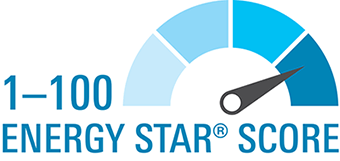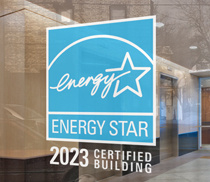About ENERGY STAR for Commercial Buildings
ENERGY STAR is a voluntary U.S. Environmental Protection Agency (EPA) program that delivers environmental benefits and financial value through superior energy efficiency. Through ENERGY STAR, EPA partners with businesses and public-sector organizations to transform the way that commercial buildings use energy. In the last year alone, the ENERGY STAR program for commercial buildings and industrial plants helped businesses and organizations save 230 billion kilowatt-hours of electricity, avoid $14 billion in energy costs, and achieve 170 million metric tons of greenhouse gas reductions.
Today, thousands of organizations use ENERGY STAR tools and resources to help them assess their energy performance, improve their efficiency, and earn recognition.
Why Focus on Commercial Buildings?
Commercial buildings and industrial plants are responsible for half of the nation’s energy use and nearly half of its greenhouse gas emissions. Much of this energy is wasted through inefficiencies. By adopting a strategic energy management approach through ENERGY STAR, it is possible to save energy, save money, and protect the environment.
Partners
Thousands of organizations have partnered with EPA and ENERGY STAR to make their properties more energy efficient, including 15 of the 20 largest school districts, eight of the ten largest healthcare organizations, state and local governments, small businesses, and multinational corporations. Learn more about partnership.
Portfolio Manager and Energy Benchmarking
 EPA’s free online ENERGY STAR Portfolio Manager® tool is the industry standard for measuring and tracking energy performance within commercial buildings. In fact, the commercial buildings market has used Portfolio Manager to benchmark nearly 30 billion square feet of commercial floor space across more than 300,000 of buildings. That's nearly 25% of all commercial floor space in the country. The tool provides dozens of energy performance metrics, and some buildings can also receive a 1–100 ENERGY STAR score, which rates energy performance in comparison to similar buildings across the country. Learn more about benchmarking.
EPA’s free online ENERGY STAR Portfolio Manager® tool is the industry standard for measuring and tracking energy performance within commercial buildings. In fact, the commercial buildings market has used Portfolio Manager to benchmark nearly 30 billion square feet of commercial floor space across more than 300,000 of buildings. That's nearly 25% of all commercial floor space in the country. The tool provides dozens of energy performance metrics, and some buildings can also receive a 1–100 ENERGY STAR score, which rates energy performance in comparison to similar buildings across the country. Learn more about benchmarking.
ENERGY STAR Certification
 Tens of thousands of buildings and plants have earned EPA’s ENERGY STAR since 1999. That means they’ve been verified to perform among the top 25 percent of similar buildings nationwide. On average, ENERGY STAR certified buildings use 35 percent less energy and generate 35 percent fewer greenhouse gas emissions than their peers. Learn more about ENERGY STAR certification.
Tens of thousands of buildings and plants have earned EPA’s ENERGY STAR since 1999. That means they’ve been verified to perform among the top 25 percent of similar buildings nationwide. On average, ENERGY STAR certified buildings use 35 percent less energy and generate 35 percent fewer greenhouse gas emissions than their peers. Learn more about ENERGY STAR certification.
Numerous independent studies have shown that ENERGY STAR certified buildings have lower operating costs, command higher rental rates, and have increased asset value. Learn more about the financial value of ENERGY STAR.
The Role of ENERGY STAR in the Market
ENERGY STAR is a partnership program from EPA that provides tools and resources to businesses and organizations that want to strategically manage their energy use. Over time, various third-party programs have found ways to leverage ENERGY STAR. For examples, more than 350 utilities and energy services companies have invested in tools that can upload utility bill data to—and download performance metrics from—Portfolio Manager. Fannie Mae, Freddie Mac, and HUD offer various green financing options for ENERGY STAR certified properties. The Federal government requires agencies to lease space in ENERGY STAR certified buildings. And dozens of state and local governments rely on Portfolio Manager and the 1–100 ENERGY STAR score for their benchmarking laws.
